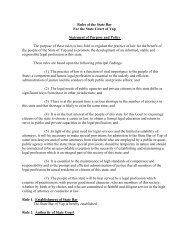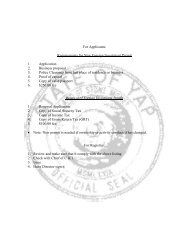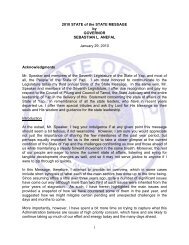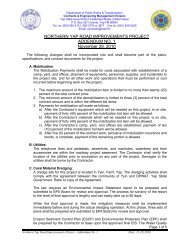CORRIGENDUM No. 2 - Yap State Government
CORRIGENDUM No. 2 - Yap State Government
CORRIGENDUM No. 2 - Yap State Government
You also want an ePaper? Increase the reach of your titles
YUMPU automatically turns print PDFs into web optimized ePapers that Google loves.
In the worked example on the previous page, the TV and refrigerator are using AC electricity so we have to<br />
take into account the efficiency of the inverter. Typically the peak efficiency of the inverter may be over 90%<br />
but in many systems the inverter will sometimes be running when there is very little load on the inverter, so the<br />
average efficiency is about 85% to 90%. Then we must divide the total AC energy used by this figure to obtain<br />
the energy required to be supplied to the inverter from the battery bank.<br />
For the worked example assume the efficiency of the chosen inverter is 90%.<br />
Daily battery load (energy) from AC loads = 1500Wh ÷ 0.9 = 1667 Wh<br />
Daily battery load (energy) from DC loads = 112 Wh<br />
To get the total load(energy) as seen by the battery, you add the two figures together:<br />
1667 + 112= 1779Wh<br />
If there are no AC loads, then you only have to work out the load from the DC appliances, and not include the<br />
inverter (or the inverter efficiency).<br />
BATTERY SELECTION<br />
DETERMINATION OF SYSTEM VOLTAGE<br />
System voltages are generally 12, 24 or 48 Volts. The actual voltage is determined by the requirements of the<br />
system. For example, if the batteries and the inverter are a long way from the energy source then a higher<br />
voltage may be required to minimise power loss in the cables. In larger systems 120V or 240V DC could be<br />
used, but these are not typical household systems.<br />
As a general rule, the recommended system voltage increases as the total load increases. For small daily<br />
loads, a 12V system voltage can be used. For intermediate daily loads, 24V is used and for larger loads 48V is<br />
used.<br />
1 kWh 3-4 kWh<br />
Use 12 Volt<br />
system voltage<br />
Use 24 Volt<br />
system voltage<br />
Use 48 Volt<br />
system voltage<br />
The changes over points are roughly at daily loads of 1 kWh and 3-4 kWh but this will also be dependent on<br />
the actual power profile.<br />
One of the general limitations is that maximum continuous current being drawn from the battery should not be<br />
greater than 150A.<br />
BATTERY SIZING<br />
To convert Watt-hours (Wh) to Amp-hours (Ah) you need to divide by the battery system voltage.<br />
For the worked example the daily energy usage was 1779Wh , so we select a battery system voltage of 24<br />
Volts.<br />
This means that the daily Ah demand on the batteries will be:<br />
Issue 1 September 2012 Page 4
















